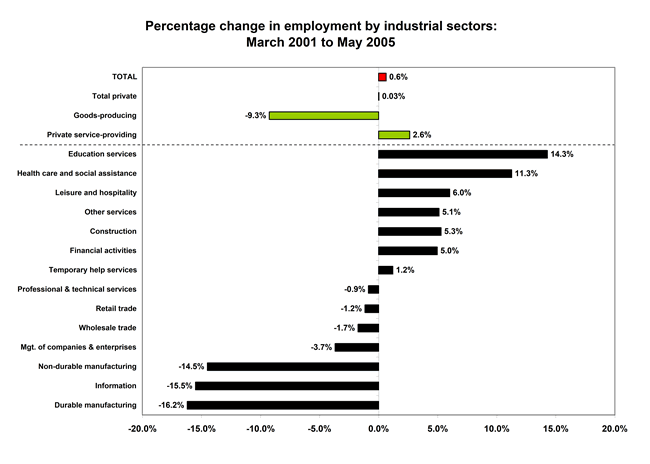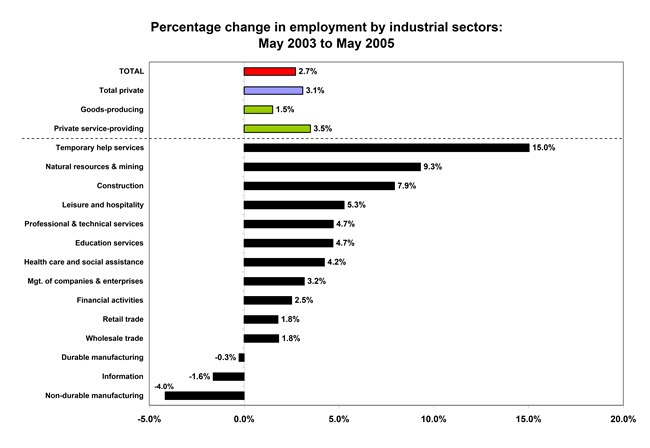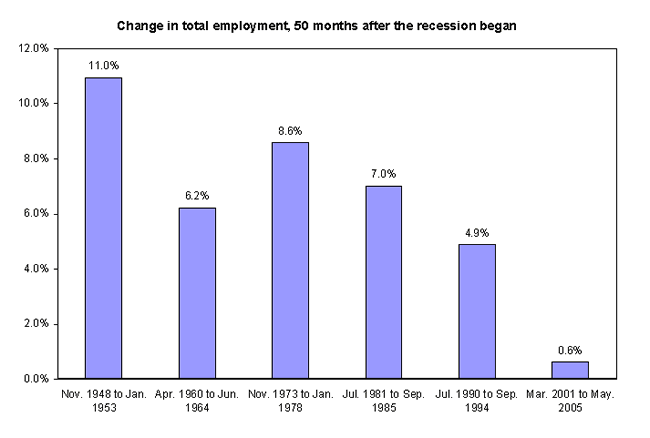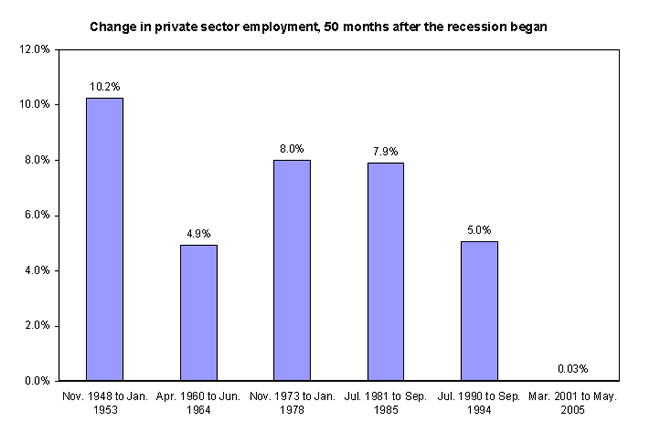
Updated June 3, 2005
Private sector recoups jobs lost since the 2001 recession; industry picture mixed
Last month, jobs in the private sector finally reached the level of March 2001, when the last recession began. The 50 months that it took to regain peak-level employment in the private sector was the longest on record. Total employment (including government jobs as well as the private sector) also took a record 46 months to recover the level of March 2001. In contrast to the 50 months it has taken to regain the level of jobs since this recession began, it took an average of 23 months to return to the level of private employment at the onset of previous post-war recessions. The prior record, set during the "jobless recovery" following the 1990-91 recession, was 33 months. (For additional analysis of the May employment numbers, see EPI's Jobs Picture.)
Private-sector employment—total employment minus the government sector—is an important economic barometer. Employment in the government sector can be countercyclical (meaning that government employment may increase during economic downturns), and therefore not reflect underlying private-sector demand.
Since March 2001, total employment is up 0.6%, while private-sector employment is up 0.03%. The overall private service-producing sector is up 2.6%. Industries within that sector that have fared well are educational services (+14.3%), health care and social assistance (+11.3%), and leisure and hospitality (+6.0%). Although overall employment in the private sector has been recouped, that does not mean that employment in all industrial sectors has rebounded. One outstanding exception in the private service-providing sector is information, which continued to be down 15.5% from its peak employment level. The largest part of the information sector is telecommunications, but it also encompasses the publishing, motion picture, and broadcasting industries.

Goods-producing sector struggles to regain peak-level
jobs
The overall goods-producing sector is still down by
9.3%—driven by employment contractions in both durable (-16.2%) and
non-durable (-14.5%) manufacturing. An exception in the goods-producing
sector is construction, which is up by 5.3%. The decreased level of
manufacturing jobs is an important development regarding employment. While
the manufacturing share of total jobs has been falling for decades, the
level of manufacturing jobs consistently remained between 17 and 19
million from the mid-1960s into the new millennium. A sharp fall in the
level of manufacturing jobs began at the end of 2000 and continued until
early 2004. Since then, manufacturing jobs have leveled off at about 14.3
million jobs.
The economy lost 1.6 million jobs throughout the 2001 recession. Another 1.1 million jobs were shed during the first year and a half of the recovery that started in November 2001. It was not until May 2003 that the trough in jobs was reached and continual positive job creation began to occur.

Since the number of jobs reached a low in May 2003, job growth has been more broadly based across industries. The goods-producing and private service-providing sectors have both seen employment gains. The most rapid growth in employment over the last two years has been in service-producing industries. Jobs in the temporary help services are up by 15.0%, although much of that growth occurred prior to last October. The goods-producing sector was up 1.5% since the end of the jobless recovery—driven by strong growth in construction (+7.9%) and in the relatively small sector of natural resource and mining (+9.3%). While jobs in the manufacturing and information sectors remain below their 2003 level, they have not fallen as fast as they did in the previous two years.
Job
recovery slowly regains ground
After payroll jobs increased by
78,000 in May, they are now up 836,000, or 0.6%, compared to the start of
the recession over four years ago (March 2001). Following the increase of
73,000 in private-sector jobs, payroll jobs are just above
pre-recessionary levels, by 33,000. The 803,000 jobs created in the
government sector since March 2001 explain the difference between growth
in total payroll and private-sector jobs. In the three downturns since the
early 1970s, the economy had not only recovered all the jobs lost during
the recession but had also generated 6.8% more jobs (7.0% more
private-sector jobs) than existed at the start of the
recession.


Copyright © 2005 by The Economic Policy Institute. All rights reserved.
|
Are the 2003 Bush tax cuts creating jobs? |
